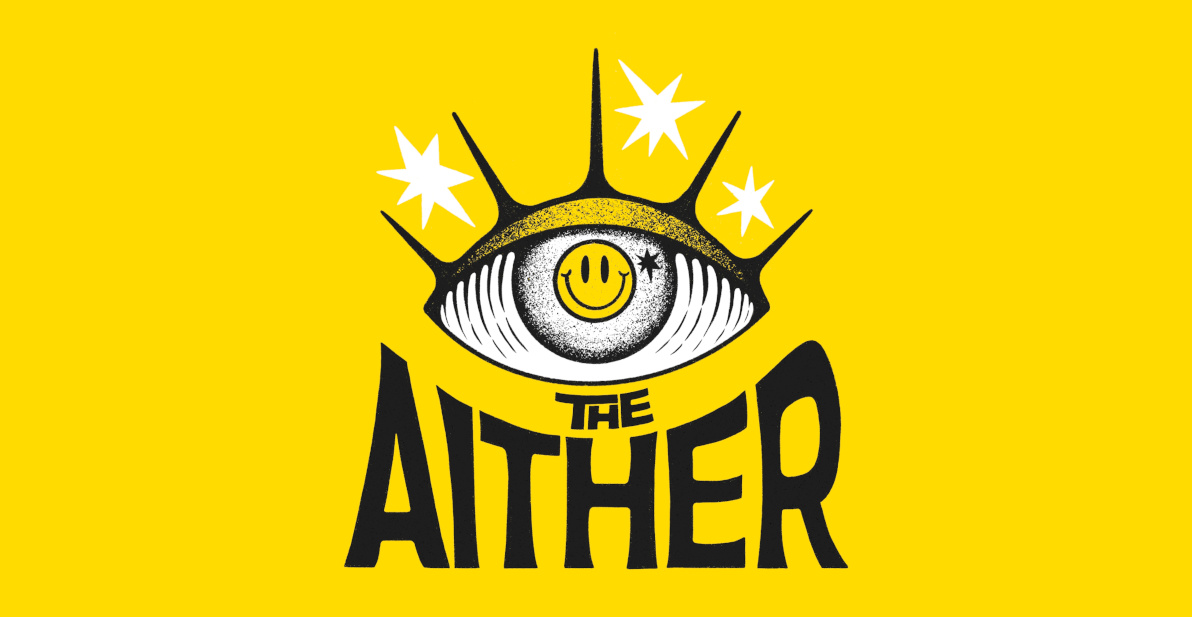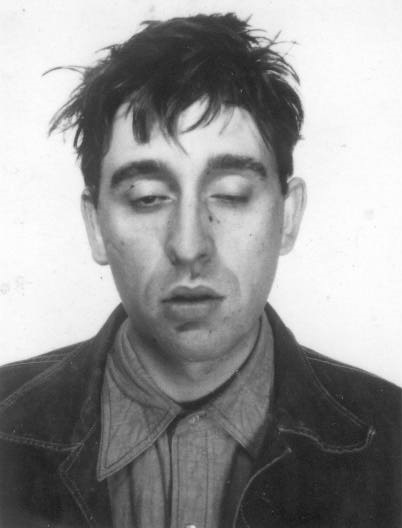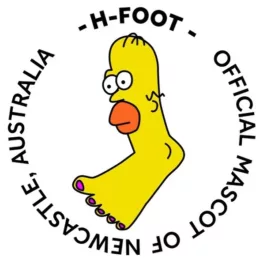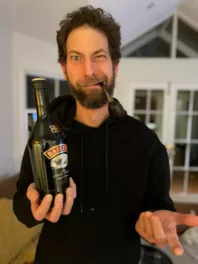Okay, Come In
I make no excuses for my friendship with Australian musician, artist, film-maker, writer, and all-round roustabout Bob Short (born 1960). I won’t eulogise him here – others have done that…
One opinion is that Bob Short has somehow managed to remain a punk. His work is still as relevant as it was then.
Nah, he was an outsider before and after he was a punk.
But we’ll get back to punk later.
Now, old farts like me keep an eye out for what the surviving punk / outsider veterans get up to. Bob Short is perhaps the most unique. For example, he’s produced a slew of glorious LPs with The Dead Rabids (which have somehow evaded the mainstream), and plays guitar in the best and most authentic Iggy and the Stooges cover band – The Four Stooges – I’ve ever seen.
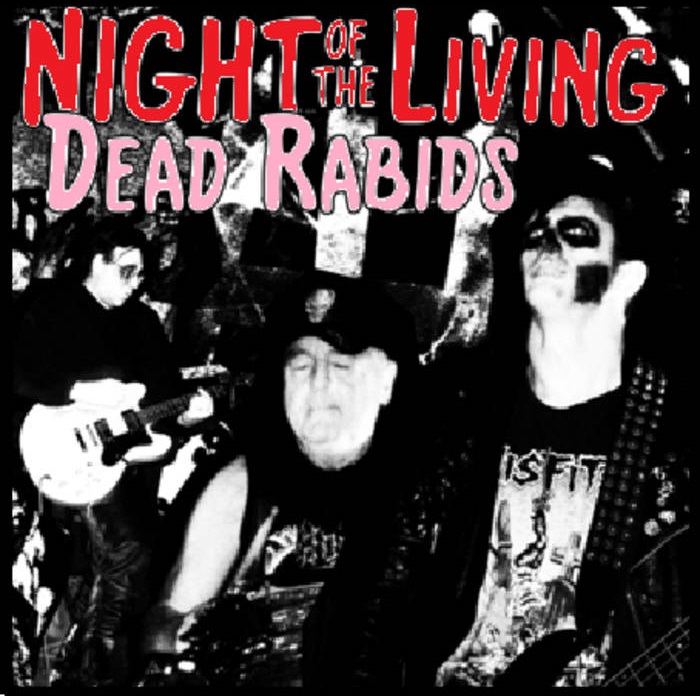
With the band featuring Bob on Guitar and Vox; Wade McPherson on bass and vox; and Phil (Bec) Beckett on drums.

So, context.
Speaking of Detroitesque rock’n’roll, you played with Chris ‘Klondike’ Masuak (ex Radio Birdman) and Murray Shepherd (ex Screaming Tribesmen) in Simon Chainsaw‘s band?
And you were in one of Klondike’s touring bands?
Bob Short: An enjoyable experience being in a rehearsal room with grown-ups who were all taking notes.
With me so far?
Okay.
Once upon a time I travelled to Sydney to see Masuak on one of his infrequent visits to Australia. The headline act was an MC5 cover band, The Sydney City 5. Support was Chris ‘Klondike’ Masuak and the North 40. Bob’s band The Four Stooges opened the proceedings.
Here’s my original reaction:
“Pissing sweat and apparently about to expire from sheer joy of playing, Bob Short (once upon a time, Sydney’s only punk) plays his guitar the closest to Ron Asheton that I’ve ever seen or heard while, the rhythm section, Steve Lorkin (bass) and Celibate Rifle/New Christ Paul Larsen (drums) kill for pleasure. Ripley Hood’s ugly, arrogant and traumatising sexuality was captivating, you wanted to grab the man and force him into the crowd.
The Four Stooges hold the viscera, balance and deceptive power in their hands and they completely, completely scrape your face… Any fan of Iggy and the Stooges will be utterly delighted by what the Four do on stage. You will be transfixed, you will laugh, you will scream.
As someone who has seen far too many ropey, too-fast Stooges covers (including Adelaide’s Raw Power, who were the first all-Stooges cover band in 1985, and Head On, who were Adelaide’s first feedback-based band), I am honour-bound to say that The Four Stooges are the best I’ve ever seen. I’d say even Iggy would be impressed…“
Link to full review: https://www.i94bar.com/reviews/gigs/256-chris-masuak-the-north-40-january-2014?highlight=WyJib2IiLCJzaG9ydCIsInN0b29nZXMiXQ==
Today, nine+ years on, I still remain impressed by that performance.
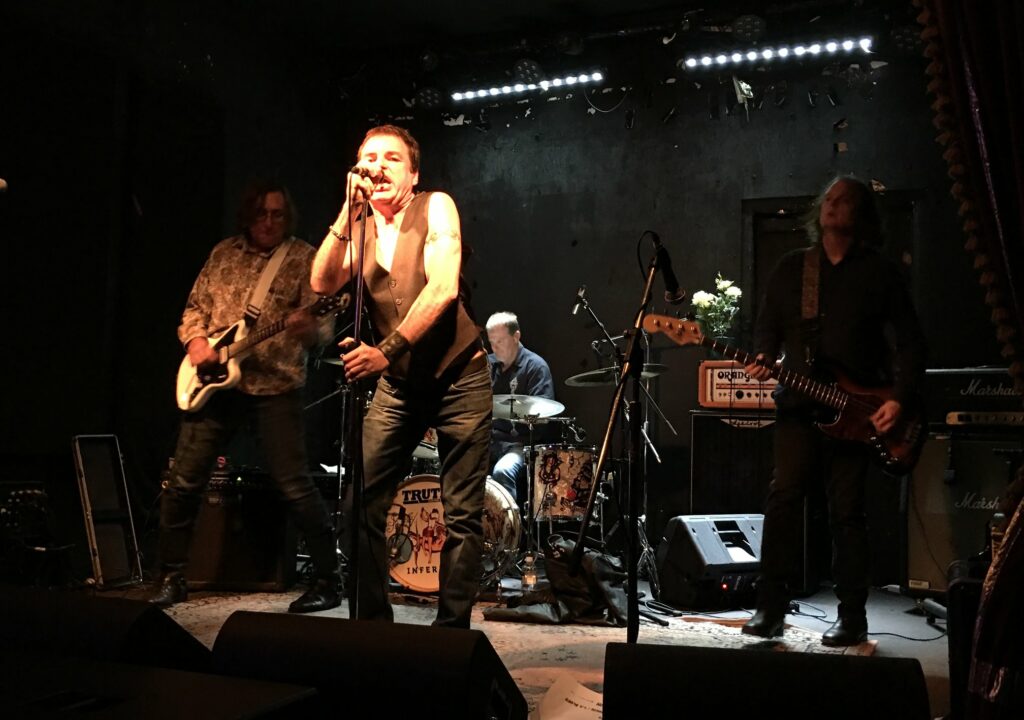
Photo by Murray Bennett.
How did The Four Stooges happen?
Bob Short: Craig Barman, who runs the i94bar.com website, asked me to do a one-off Stooges cover band, but Steve Lorkin (bass) is like me – an obsessive Stooges nerd – so it was bound to turn obsessively fanatical.
So how did our friendship start?
Well about fifteen years back, I wanted to connect with him, so I found an excuse and called.
He was busy at his day job, which (on that day) involved shoving lengths of metal up puppet’s bottoms.
I cannot for the life of me recall why you were doing that, Bob.
Do you recall?
Bob Short: I was repairing a rod puppet that had been mishandled by an abusive puppeteer.
To me Bob Short is the real deal; not widely known outside a certain coterie, his creative combine harvester rolls down the streets, strangely un-noticed. And, we’re not talking about some prolific hideaway squirting out random stuff during lockdown or the dole, okay?
There are 24 EPs, singles and LPs available on Bob’s Bandcamp page, spanning 46 years of constant, whirling musical creativity.
Link: https://deadrabids.bandcamp.com/music
Forty-six years.
Dear god!
I’ll also say that Bob’s aforementioned band The Dead Rabids are the best punk band you’ve never heard (they existed from maybe 2007 to about 2014).
And that his first band, Filth would’ve been not so much the ‘best’ punk band, but the most punk punk band you’d ever experience.
He also knows London’s legendary Kings’ Road well, having lived in the city for several years in the late 1970s, into the 1980s.
Today, Bob Short is notorious to some, yet in his neighbourhood he is known as a cuddly, cheery chap.
He’s the real deal – light and shade.
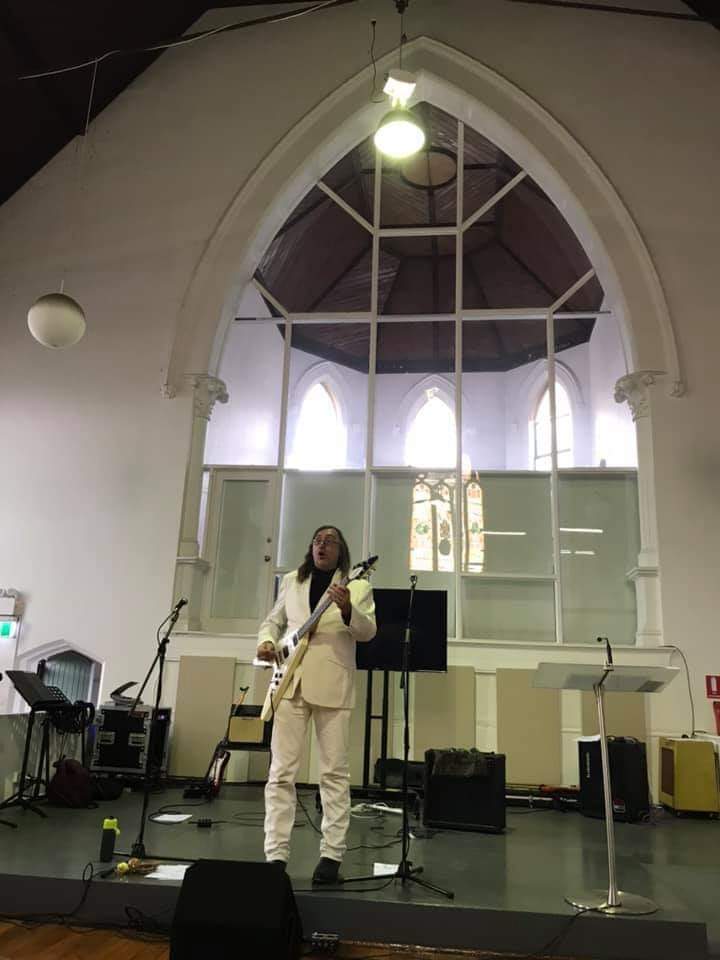
He doesn’t look so hail-fellow-well-met if you see him negotiating and enduring the endless cartographical and logistical nightmare of the Sydney transit system. In fact, much of this interview was conducted while Bob was on trains or buses, via email and (anti)social media.
To me, Bob Short is not so much a punk as an outsider artist. In short (ahem) I think of Bob as the outsider’s outsider.
With the Tate Gallery defining Outsider Art as:
“Art that has a naïve quality, often produced by people who have not trained as artists or worked within the conventional structures of art production.“
Well, that certainly seems to embrace much of what Bob Short does creatively – Over the years his rampant creativity has plunged him down a number of quite extraordinary rabbit-holes.
He didn’t intend or plan for all of this to be – however.
Bob wanted to be a rock star.
Punk would have been his ladder.
Well, maybe.
He was a teenage runaway.
Could rock’n’roll yank him out of poverty, at least?
Before we answer that question – we should investigate what inspired Bob to begin with…
First There Was Music
So where did Bob Short, outsider at large, get his start?
Was there a record which changed the world for you?
Bob Short: I think narrowing down a ‘world changing record’ just to one would suggest a fairly narrow world view. Plenty of records have had their wicked way with me, bashing me through walls I had not previously imagined.
The first was a 45rpm freight train called 48 Crash by Suzi Quatro. Obviously, there was some kind of sexual awakening involved but equally there was the sheer carnal primitivism. Part of the fury arose from the slight speeding up of the track post-recording, adding an unnatural desperation to the screams. But the second that needle hit the groove, I was aware I wanted not only for this to be in my life but to be my life.
A key track in Bob’s musical, personal, and artistic development.
There was a whole world of desperate glam recordings tearing out of transistor radios everywhere.
I soon accumulated a pile of 7-inch joy including stuff like the Sweet’s Ballroom Blitz; Sparks’ This Town Ain’t Big Enough For the Both of Us; Brian Ferry’s Hard Rain; and its equally delightful b-side 2HB. Probably not as life changing as Suzi’s leather-clad roar, but they became close friends and I clung to them as all around called them unsophisticated rubbish.
I suppose the next world-changer was the Velvet Underground’s White Light, White Heat.
Miss Campbell, our High School science teacher, and the closest thing I knew to cool, had mentioned in class that she liked Lou Reed. Being proactive, I thought I’d investigate Mr Reed’s work.
His LPs floated before me in the $5.95 price bracket, far above what could be saved from pocket money and missed school lunches. At the back of the rack, for the knock-down price of $2.99 was a copy of the Velvet Underground’s White Light, White Heat. I seized upon it only to discover music could be a rather different phenomena than could be heard on radio stations like 2WL or even the far groovier 2SM.
Feedback had entered my life and I would not be truly satisfied until tinnitus eternally echoed that sound in my head.
I also discovered the rule book of good taste and somnambulist technique was not going to be playing a large role in my musical odyssey.
I suppose it wasn’t that hard to discover the New York music scene from there.
From a brief mention in RAM (Rock Australia Magazine), I kind of got excited by the idea of the New York Dolls. When I saw a copy of their debut album in a second-hand record shop, I snapped it up.
I suppose it was the lyrics which changed my world. It was a realisation that lyrics didn’t need to be stupid or crass. You could actually describe the world in a way that was smart but not smug.
Some bands seem to think fussing about bustles in the fucking hedgerow made you sound intelligent. The New York Dolls raised a single painted-nail finger to that bullshit.
And then we had a few glorious months where every album coming out of New York kicked the shit out of the dreary Status Quo. [The band and the concept…]
When The Ramones played it one way, Television seemed to do the exact opposite.
I should probably mention the Stooges’ Funhouse and Raw Power too.
For different reasons, they were records that told you that you could never go home ever again.
And speaking of records that pushed you over the line, hearing Anarchy in the UK for the first time made high school redundant.
It made living with your parents redundant.
That was a record to change your world.
I realise that, these days, it’s just a cliché but, at the time, that was the end of days.
One of Bob’s much loved songs.
I can keep rattling on about records that changed me…
Hole’s Northern Star made me stop playing music for five years because I didn’t feel I could deliver anything of that emotional intensity.
Soundtrack albums like Morricone’s Once Upon a Time in the West, John Carpenter’s Halloween; and Goblins’ Suspiria; have all had shattering implications on me about the way music is composed and its use in creating emotional effect.
Well, you asked.
Bob, Sydney, & The Development of Punk in Australia (1974 – 1978)
The Australian city of Sydney is an important key to unlocking and understanding Bob. Aside from its beaches and rampant commerce, the city also has a reputation – both locally and internationally – for groundbreaking underground music: Think Radio Birdman, Rose Tattoo, X; to The Hard Ons, The Beasts of Bourbon, and Mortal Sin in the 1980s; and, today, with bands such as Royal Headache.
(Of course, it also has several other reputations. While history cannot ignore the blues-rock scene in Sydney, this is my article and I am gonna pull the chain on it.)
The early bands such as Birdman had a huge impact on the Australian music during the mid to late 1970s, altering it beyond recognition, and inspiring the Sydney’s nascent punk scene. However, they were not on the radar of local radio stations. In fact, the entire musical underworld of the day slid beneath commercial radio and general acceptance, a situation which largely remains the case today.
Now, moving backwards…
During the mid-late 1970s there were multiple streams of musical choices to be had in the underground, streams slowly feeding a massive dam… and then the dam broke, and suddenly everyone was suddenly punk or wanted to be or (far more frequently) pretended to be.
During this fertile period, teenage runaway Bob Short was one of the regulars at Sydney’s inner-city suburb of Darlinghurst’s venue, The Funhouse – the ground-zero of Radio Birdman’s trajectory. Located on Oxford Street.
How did you discover Birdman?
Bob Short: I’d bought the Birdman EP unheard [released October 1976], based solely on comparisons in ‘RAM’ mentioning the Stooges and the MC5. There was a live at the radio thing on Double J just after that.
Then I saw them live at the start of 1977 by wagging school and catching the train up from Wollongong.
The dates are more of a blur these days than I’d like.
Shortly afterwards Bob became one of the founding members of Sydney’s first self-proclaimed punk band, Filth (they were so-named by an outraged mother with two kiddies in a hamburger emporium).
All you need to know about Filth is that they were very good, physically confronting, and often played the Stooges’ LA Blues to end their gigs.
(For the uninitiated, that song is a violent jam which more closely resembles feedback-drenched free jazz – most Stooges fans don’t even listen to it because it’s just tooooo much.)
Filth did maybe 20 to 25 gigs during their life. In that space of time, there were at least four drummers. Five bass players. With Bob Short as guitarist and Pete Tillman as vocalist in all but the last two gigs…
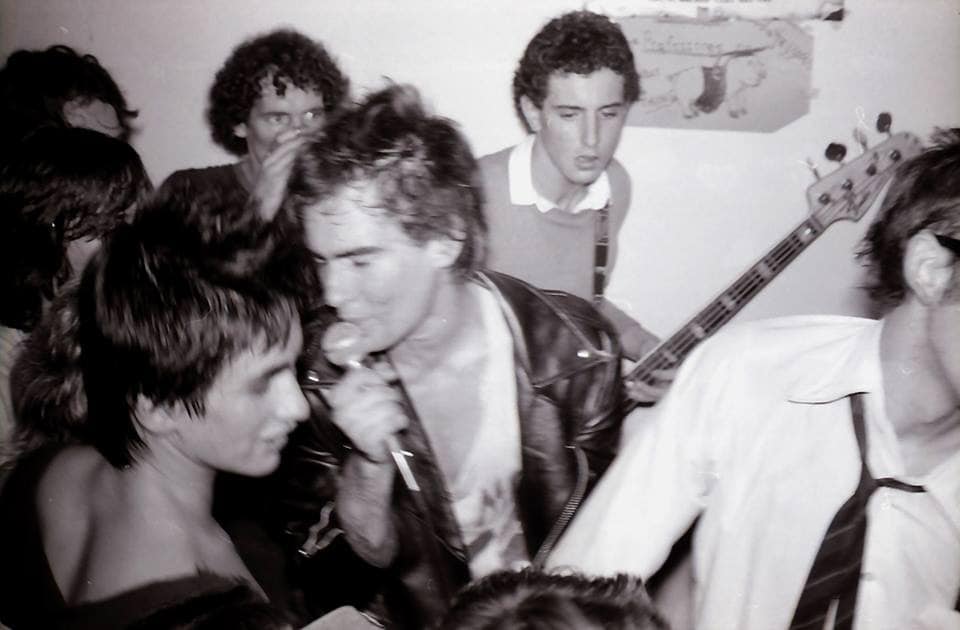

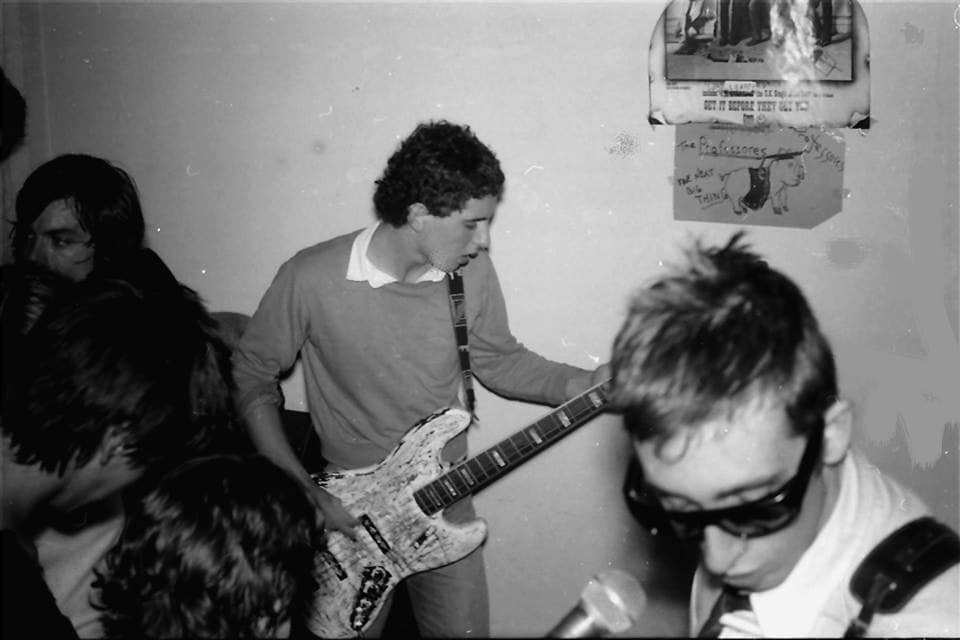
Now, you may have heard of Nick Cave.
Ah, excellent, you have.
Okay, well taking a turn to Melbourne – another Australian state capital; known as the darker and artier version of Sydney’s high commerce, sunny party town – the band Nick was a singer in, The Boys Next Door, accepted an offer from one Barry Earl, a representative of Mushroom Records subsidiary Suicide Records to record a few songs for the eventual 1977 compilation LP, ‘Lethal Weapons‘.
Here’s legendary rock writer Stuart Coupe (from Coupe’s biography of Mushroom Records founder Michael Gudinski) on it all:
“Punk rock was changing the face of the Melbourne – and national – music scene.
While much of it was right under Gudinski’s nose it took an old-school music hustler by the name of Barry (or Barrie) Earl to push him into exploring if there was a serious earn to be made… The basic idea was that Suicide would sign the cream of the punk/New Wave bands, with an emphasis (as usual with Mushroom ventures in those days) on Melbourne-based artists …
Many of the bands – especially those smart enough to get legal advice – kicked and screamed about a number of aspects of the Suicide/Mushroom contract, in particular the clause which held all participants to a ‘future publishing rights’ deal. All the artists would be obligated to record for Suicide/Mushroom for a further five-year period if the record company so desired.
On the other hand, the label had no actual obligation to do anything at all.
It was a typical record deal of the time – and one that hasn’t changed much over decades. The label holds all the cards and the artist does what they’re told.”
[Per: Stuart Coupe: Gudinski: The Godfather of Australian Rock; Hachette, 2015.]
Because the ‘Suicide record’, as it became known, gave The Boys Next Door a contract with Mushroom, this allowed a bit of national exposure, and as it turns out, started Nick Cave on quite a trajectory.
The LP also gave oxygen to The Models and The Sacred Cowboys – the other bands on ‘Lethal Weapons’ mostly split quite quickly, but their members now had recording contracts.
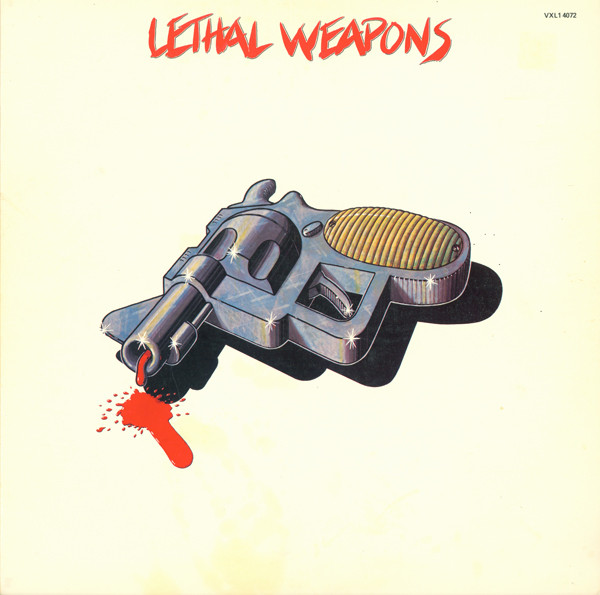
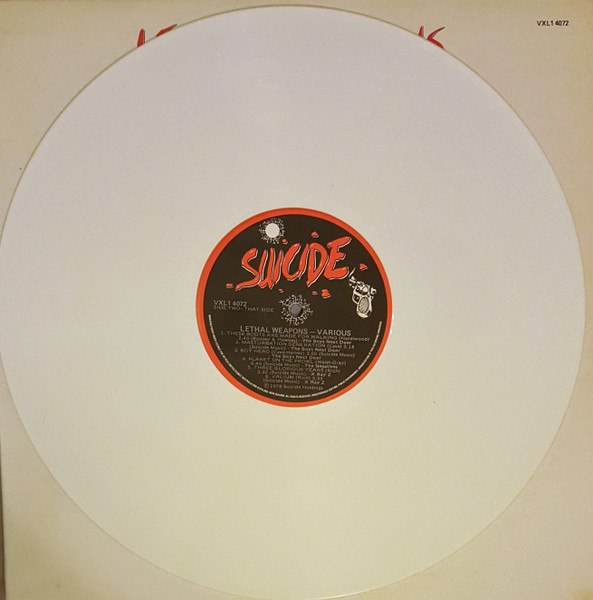
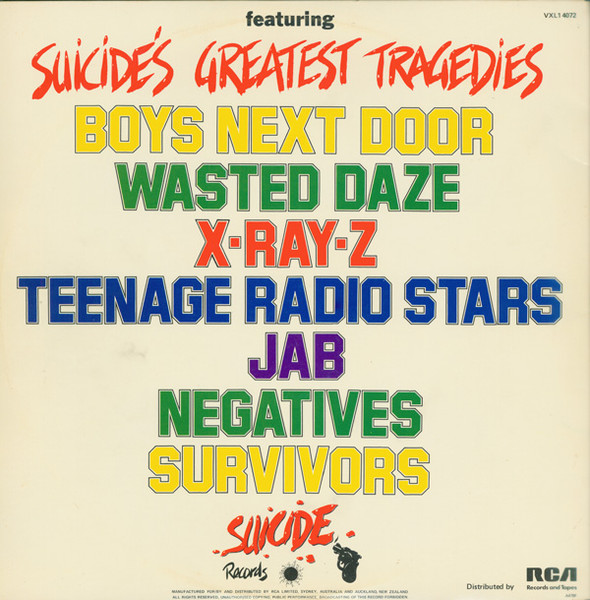
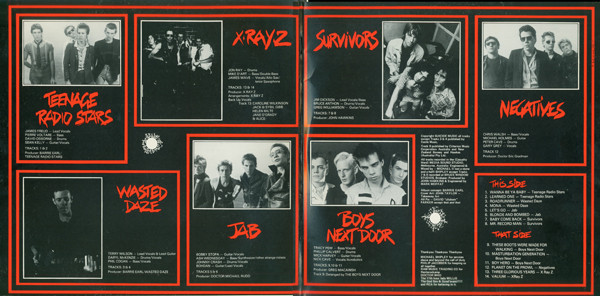
A record Bob and his band Filth refused to appear on, in their own unique way.
Now then – quite a few bands were asked to play for the compilation, and not a few refused. The aforementioned contract certainly put some off. Some music historians have put this down to some sort of noble sticking to political stances. However, bands like The News (aka The Babeez) refused point-blank – and so did Filth.
I’ll say it more prosaically – Barry Earl appeared to be one of very many who infested the music industry. Money, sex, and drugs swirled through it at the time; and still do. It was, and is, a corrupt and corrupting place.
Bob Short: Filth were playing a gig at a school hall in North Sydney. That Barry guy from Suicide Records rolls up and I guess you could describe him as a cigar-chomping sexual predator.
The music business was full of them in those days. If you wanted to bend over backwards to please them, you’d go at least a little further up the pecking order.
Barry was trying to hold court, being the mighty man from Mushroom.
Pete Tillman, bless his cotton socks, threw a chair at him.
Off he trotted back to Melbourne.
Recently, I was asked, “What if he hadn’t thrown the chair and you’d signed to Suicide?”
My answer was simple. If Tillman hadn’t thrown the chair, I would have.
In many ways it was better that the original line-up of Filth was not recorded. Some things are of the moment and should be legendary rather than physical.
Myths have great power.
So.
Imagine. Just imagine.
Step into Bob’s shoes and engage in some time travel…
You are 17.
It is 1978.
You are one of Sydney’s first punks with a couple of years’ worth of seeing gigs in the creatively fertile and violent Sydney underground.
You are also a member of Filth, Sydney’s first self-declared punk rock band.
Improbably, stupidly, you tour one of Australia’s most remote State capital’s, Adelaide; with The Psycho-Surgeons. Whose only self-released single is now a ferociously-sought-after rarity.
You play a gig in the cellar of the Governor Hindmarsh pub, for their very first ‘rock’ gig. During which you have done your damnedest to produce a riot amongst a small crowd of confused disco trendies, himbos, bimbos, assorted trannies and possibly Don Dunstan (oh, and an even smaller crowd of the well-informed and curious): Smashing your flying-V guitar to splinters, cutting yourself dreadfully, and promptly getting banned from the venue.

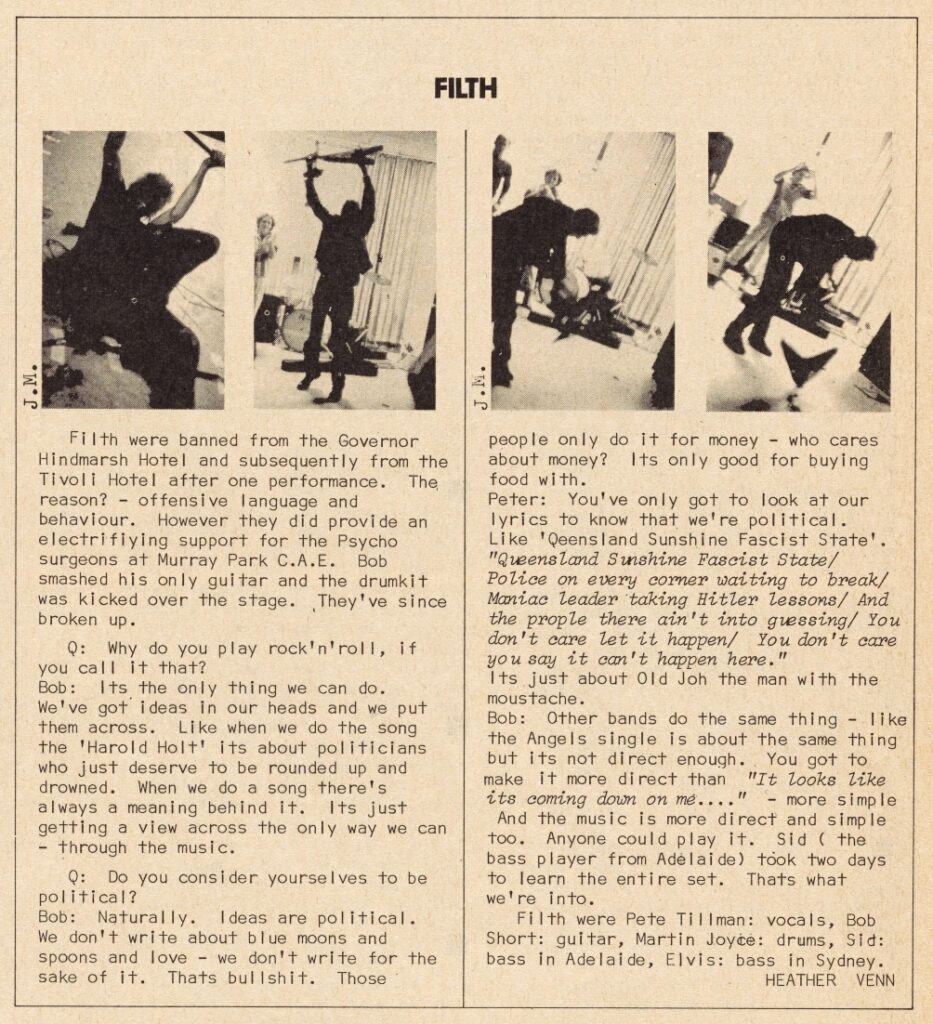
Anyway, after this gig a rather brawny, scruffy looking dark-haired stranger with a few teeth missing approaches you.
Unbeknownst to you, the stranger is Turk Nancarrow; and between working at one of Adelaide’s hip record shops (the Record Factory) he is the drummer for local outfit The Dagoes.
The exchange goes a little like this:
Turk: ‘D’you know such and such?’
Bob Short: ‘Yeah…’
Turk: Did you go to blah blah school?’
Bob Short: ‘…Yeah.’
Turk: ‘Is your mum so-and-so?’
Bob Short: ‘What the fuck is it to you?!’
Turk: ‘I’m your brother, knucklehead.’
Bob Short: Yes, it happened – but I did know I had a brother. I just hadn’t seen him since he vanished from home into the Kings Cross drug scene of the early Seventies.
There’s probably some kind of ancestral trait that runs in the family…
Apparently, my maternal grandparents were alcoholic seaside performers who abandoned my mother to an orphanage. She literally came home from school and they were gone.
So obviously, there’s some damage passed generationally along the family tree.
I was too young to see Filth.
Bob Short: Filth were my first band. Calling them an art project would have been beyond us at that time. But, in hindsight, we were definitely a punk rock art project.
Being one hundred per cent serious and one hundred per cent taking the piss simultaneously required a delicate balancing act obtainable only through naivety.
We didn’t so much want to be a punk band as genuinely wanting to be what the general public assumed punk rock was.
We didn’t practice and we were utterly belligerent yet possessing the beauty of gilded youth.
That we achieved our goal was down to good luck and through the sweat of our brows and the mangling of our bodies.
But the most beautiful of flowerings are short-lived and it is best audiences are left with anticipation rather than expectations that can never be met.

Yeah, yeah, then what happened? (June 1978 – March 1979)
Bob Short: The Urban Guerillas was my next band, started in June 1978, immediately after returning from the Filth tour in Adelaide – There’s another band of the same name (originally from Adelaide) who continue to this day who are unrelated. My band played mainly at the Grand Hotel.
The Guerillas were deliberately more political and I had written probably 100 songs in Filth and wanted people to recognise them as songs. There was a fair bit of New York influence in the music.
The band was tight and energetic and singer, Andi last name Guerilla – nobody had last names in 1978 – remains unrecognised as the first great frontwoman of Australian punk.
Last gig was March of 79, though I believe they did a couple more gigs with Danny Rumour on guitar.
After the Urban Guerillas I got bored with Sydney or had some kind of manic episode, or epiphany, or psychotic break, or all of the above.
These days I can recognise neuro-divergence as a definition.
At the time there were no definitions.
Are there any recordings of either Filth, or The Urban Guerillas extant?
If so, will they be released?
Bob Short: No recordings besides abhorrent live cassettes.
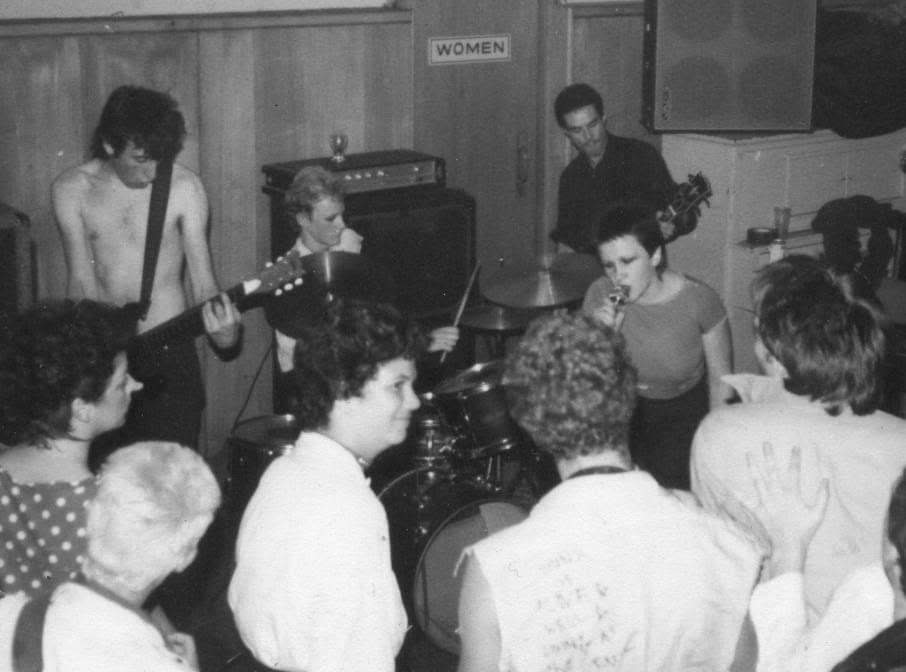
Bob in London, UK (1979 – 1997)
In March 1979 Bob then travelled to London, England in search of fame and fortune…
Instead finding near-starvation, ghosts, decadence, and a brief spark of notoriety when he appeared on the front cover of the February 10th, 1983 issue of the ‘NME’ with his band Blood and Roses. Who also included members Lisa Kirby (vocals), Richard Morgan (drums), Jez James (bass), and Ralph Jezzard (bass).
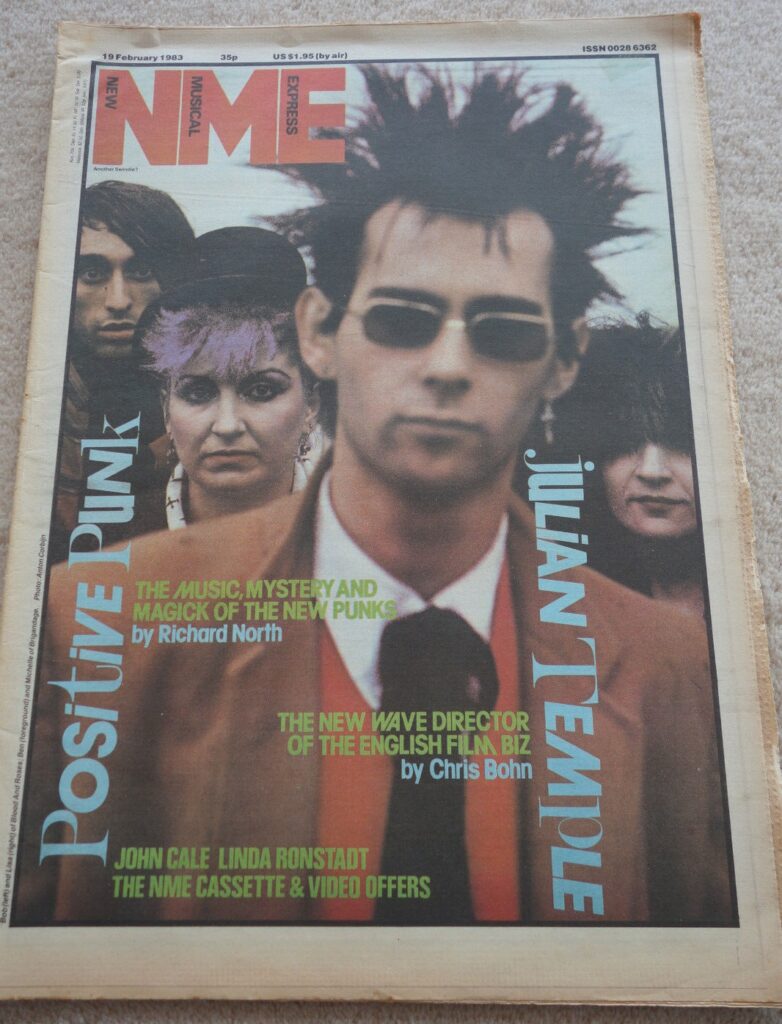
So, after Filth, you packed your guitar, headed for London, which is where the UK music press, declared all the action was; and eventually formed Blood and Roses?
Bob Short: The band I achieved most success with was Blood and Roses in the UK. We essentially started with the same set list as I’d been playing with the Urban Guerillas.
You’ll probably note by now how important these songs remain for me.
I always like to evolve lyrics because when you write for the times, times continue to change. The principal change with Blood and Roses was the influence of post-punk and film soundtracks.


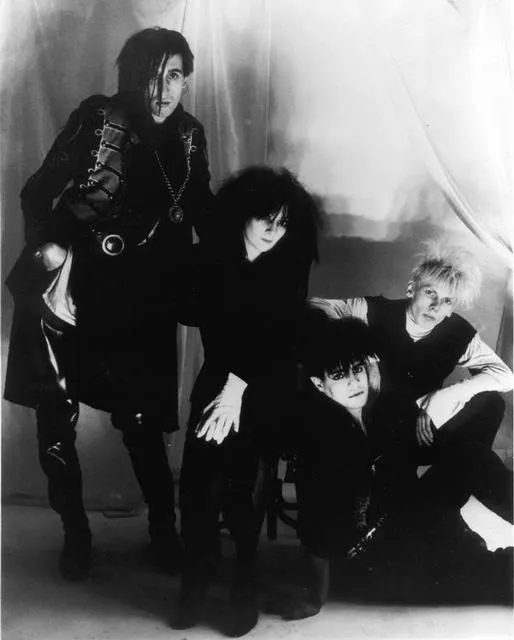
From left to right: Circa 1983 at Centro Iberico, photo by Erica Ekinsberg. Circa 1981 in Clapham; and a 1983 promo photo by Mike Laye.
In London, all of Blood and Roses lived in the scummiest of punk squats. We were the vilest of street urchins. Barely washed and spikiest of hair. Booze and drug ridden vermin constantly drawing attention of the local constabulary but unwanted in the music venues.
Were Blood and Roses a punk band?
Genre-addicts would say no.
These days, people talk about punk in terms of bands whereas I considered it a gathering of like-minded freaks.
Blood and Roses made records popular enough to bother the independent charts, get John Peel sessions and appear in the music weeklies (NME, Sounds, Melody Maker).
[Editor: In the UK, these three magazines were known as ‘the inkies’, after the amount of ink which would cover your fingers and hands as you read them, due to their cheap print quality.]
But the music industry sucked. Unless you sucked it, and we were the kind of scummy punks who lived in hell-squats and didn’t play well with others.
So that didn’t last.
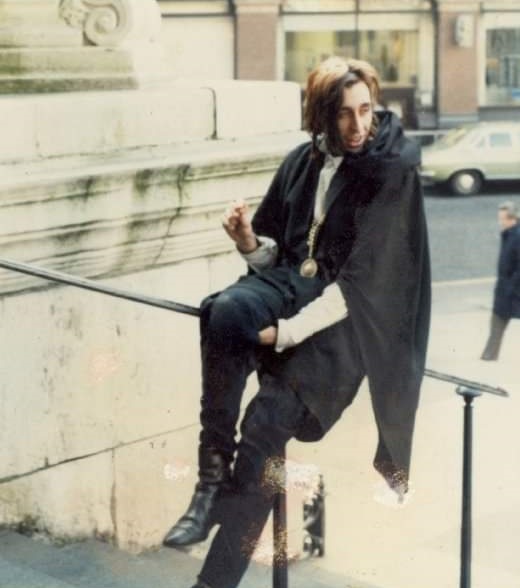
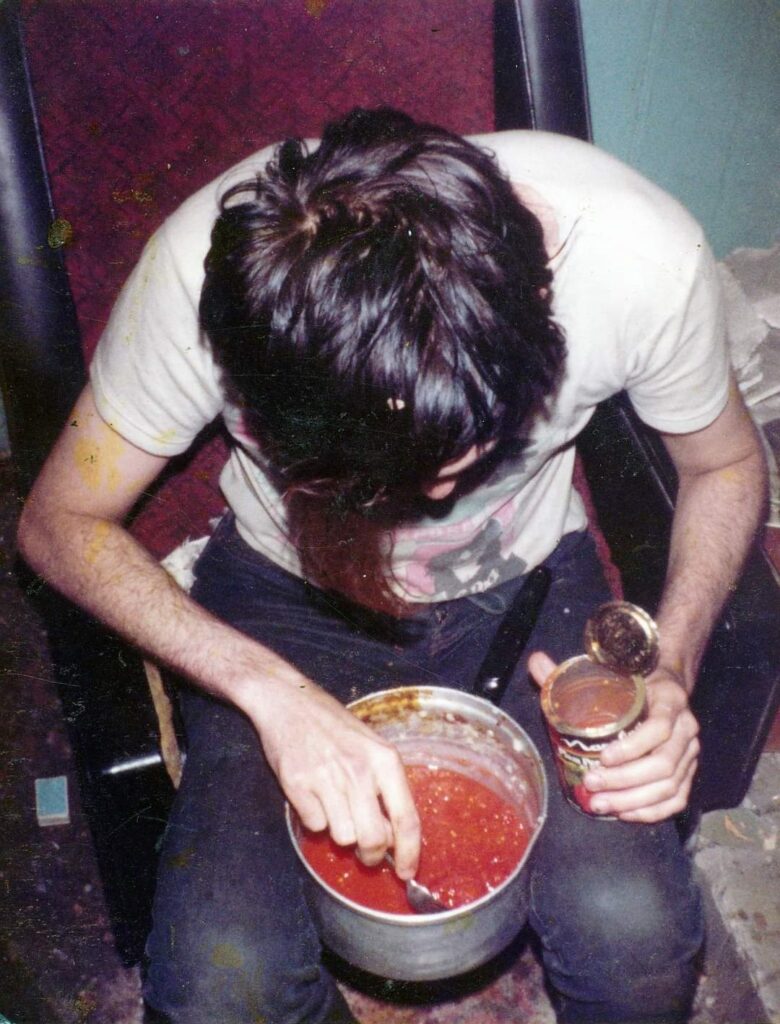
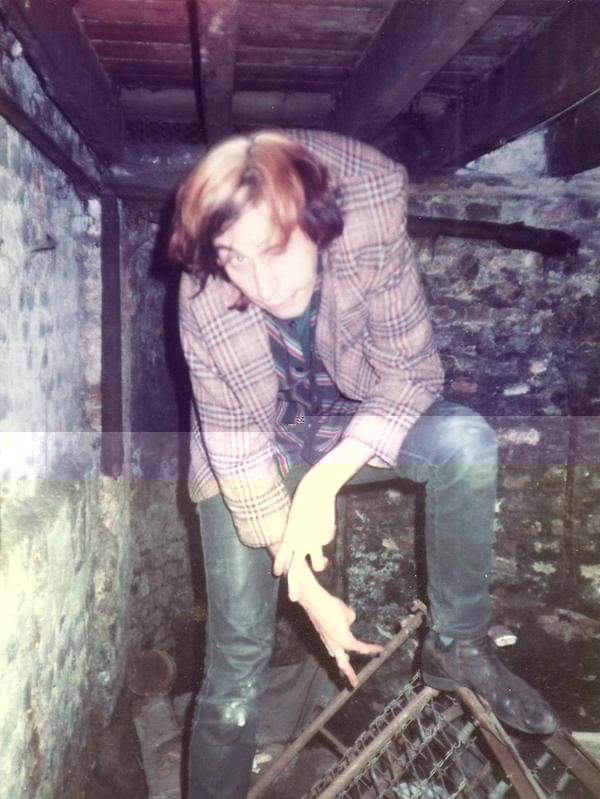
From left to right: Signing to Kamera Records at St Paul’s Cathederal, circa 1983. Making spaghetti at Bayston Rd; in Stoke, Newington, circa 1982; and play acting as Quasimodo at Yoakley Rd, Stoke, Newington, circa 1981.
Return to Sydney – New Bands, Adventures in Films & More! (1992 to the New Millennium)
Then what happened?
I became a single father in 1998, but when my son was born in 1992, I’d pretty much worked out that my selfishness could take a step backwards.
I still made stuff for community television like the twenty-four episodes of Kings Cross Vampires, and the controversial Lone Gunman Theory which garnered attention from the Commonwealth Police, and Jesus Christ Almighty which upset all the religious groups on community television but only after its third broadcast. I was no longer welcome.
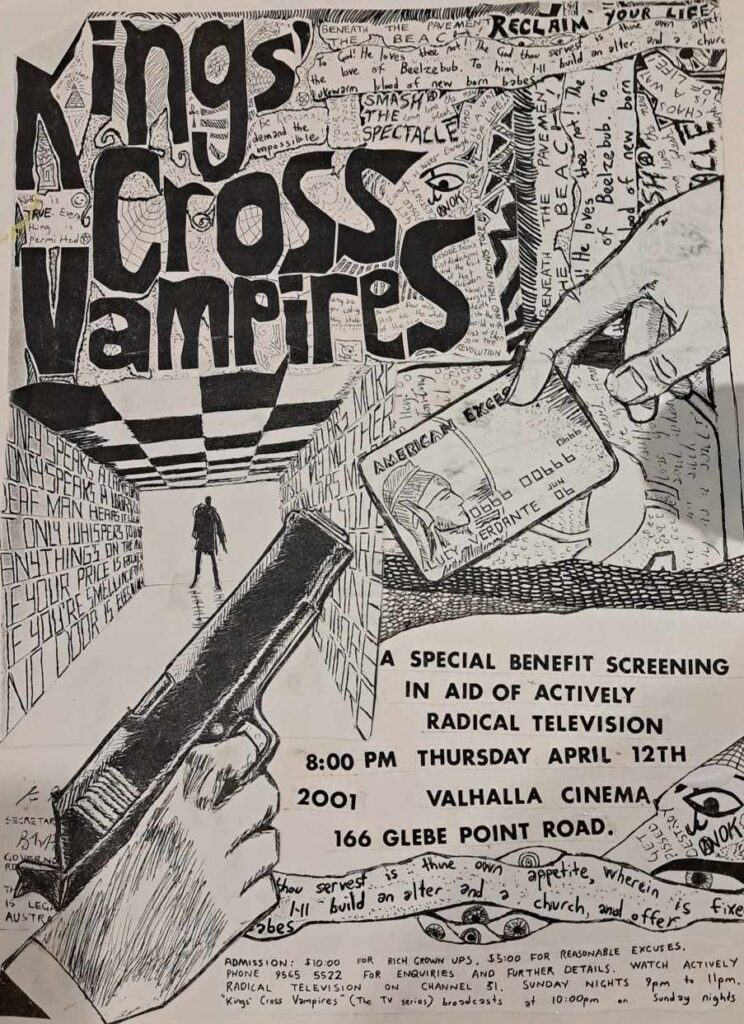
KXV was just before 2000; it was a bit of an irregular spread. Lone Gunmen Theory would have been 1998. And Jesus Christ was a bit of a quickie. Maybe 2001. I was doing so much stuff around that time it kind of blurs. There was shit tons of music clips too. Sorry can’t be more specific.
Safe to say all this stuff happened between 1998 and the twin towers going down.
Are there videos of Kings Cross Vampires, Lone Gunman Theory, and Jesus Christ Almighty?
Bob Short: There are no episodes of Kings Cross Vampires on Youtube. When community TV was happening, it was the wild west and we used whatever music we liked. Kings Cross Vampires had a Pulp Fiction level soundtrack which would never fly these days.
Jesus Christ Almighty was up on YouTube. It had the lowest production value as I tried to make it look like play school produced by hill-billys. It might still be there.
Lone Gunman Theory is probably a lost film. I might have a VHS copy.
The seventy-minute film told the story of a hit man who tries to amend his ways by killing evil people. He finally settled on killing Pauline Hanson [Editor: Australian politician]. Hence the interest of the Commonwealth Police. It upset some right-wing radio wankers.
Hilariously, Pauline then recorded her, “In the event of my death,” video.
At that point I had pretty much settled into doing music for videos and theatre.
I had seen a performance by Hole with Courtney Love doing an acoustic version of Northern Star. It was so raw and hurt that I couldn’t imagine getting on stage again.
If I couldn’t deliver anything that authentic, I didn’t belong up there.
About ten years later, I kind of got the bug again when I was asked to fill in on bass for a local band called Gas and the General. I started looking at the songs I had recently written like Sound of my Broken Heart and figured that was something I could do. The Dead Rabids pretty much came out of that. We played around Sydney to a law of diminishing returns.
The band essentially faded away.
Is there any footage of the Dead Rabids? For a band which produced a slew of LPs you didn’t say much about them!
Bob Short: A few live clips on YouTube.
Bob’s New Comic ‘Red, White and Blue: A Comic Trilogy’ – 2024
Right – So let’s look at Bob’s recent project, which saw him taking up the pastels, scissors and glue to produce and self-publish a graphic novel in three parts: Red, White and Blue.
First, why is Red, White and Blue a trilogy?
Bob Short: Red, White and Blue is a trilogy mainly because I worked out that was the only way I could print it. What are often called graphic novels are, with noticeable exceptions, collections of parts of ongoing, serialised books, so, it’s not that unusual.
What is more unusual is that this is a finite self-contained story.
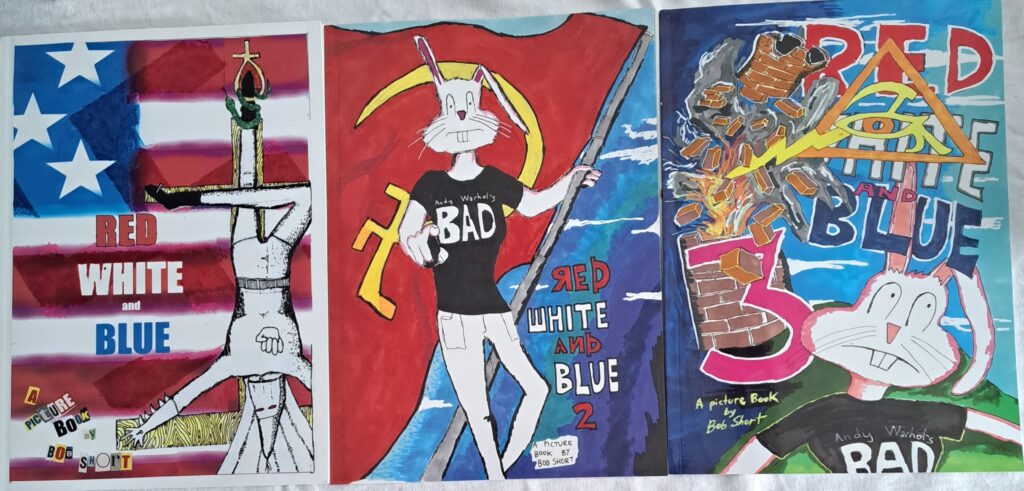
Published in 2023.
How did it start?
Bob Short: In the nineties, I wrote a novel called Red. It was set in two worlds, an Eighties post-punk squat nightmare world and a dream world.
Publishers reacted like I’d taken a dump in their mail box.
The central conceit of a world where your life continued into your dreams was not new. Jonathan Carroll’s Bones of the Moon springs to mind as well as Neil Gaiman’s A Game of You arc of Sandman. But I was really digging at surrealism in movies and Jungian notions of archetypes and psycho analysis.
I particularly was motivated by Dali’s dream sequence in Hitchcock’s Spellbound using the dream to propel plot and solve mysteries.
Over the Covid break, I rewrote the book, moving the real-world action into the milieu of alternate truth and the decay of democracy. The dream world stayed the same.
I put that book out on Amazon and it vanished in disinterest.
One morning I woke up and decided it should be a comic.
And here we are.
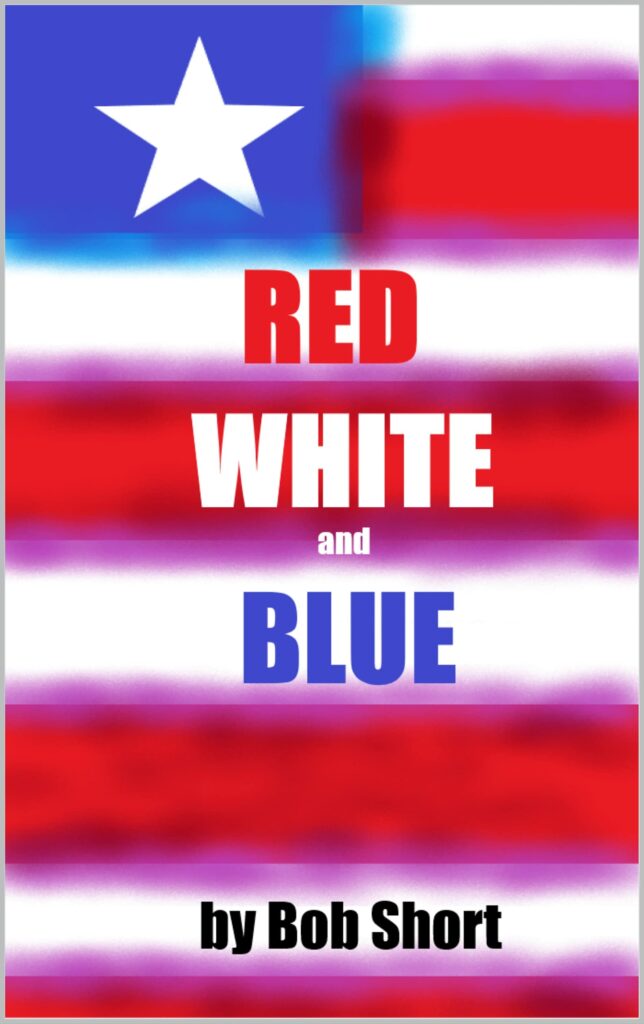
Which preceded and inspired Bob’s recent comic of the same name.
Please tell us about your other books and comics – such as ‘Trash Can‘ (2006), ‘Filth‘ (2009), and ‘Makers of the Dead’ (2024)?
‘Trash Can’ was a book I wrote for the publisher Independence Jones. It’s still available on Lulu. It was really a collection of things I’d written for a variety of websites.
‘Filth’ was the follow up but I wrote some articles about the band Filth to create an internal narrative.
‘Makers of the Dead’ is a comic adaption of the movie featuring some of the “actors” from ‘Red, White and Blue.’ It is also an exercise for me in writing a concise narrative with at least one joke on each page.
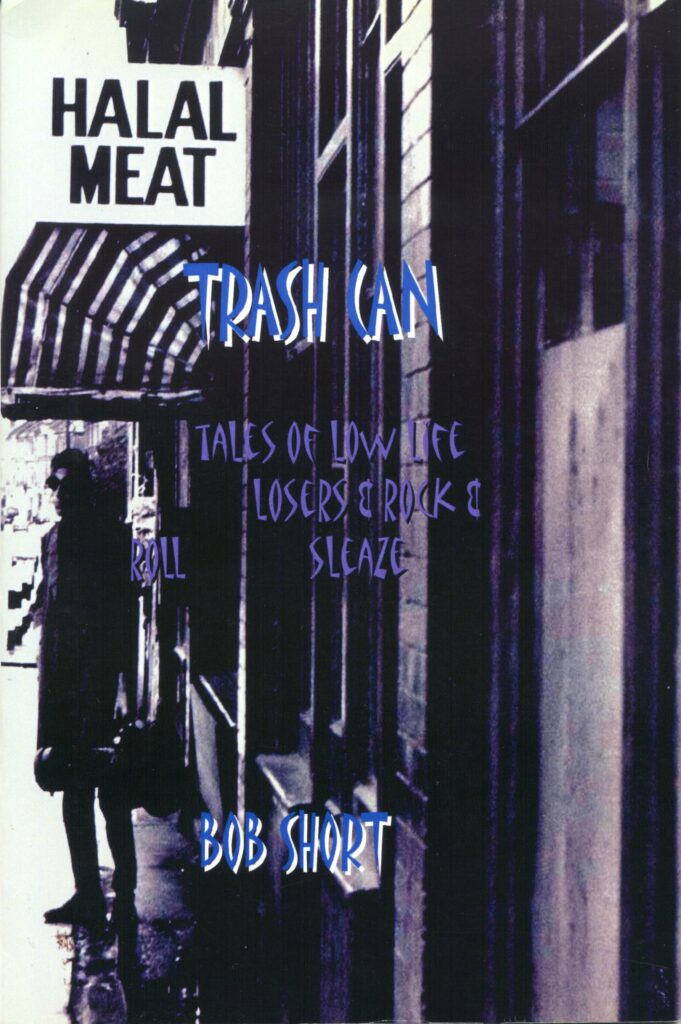
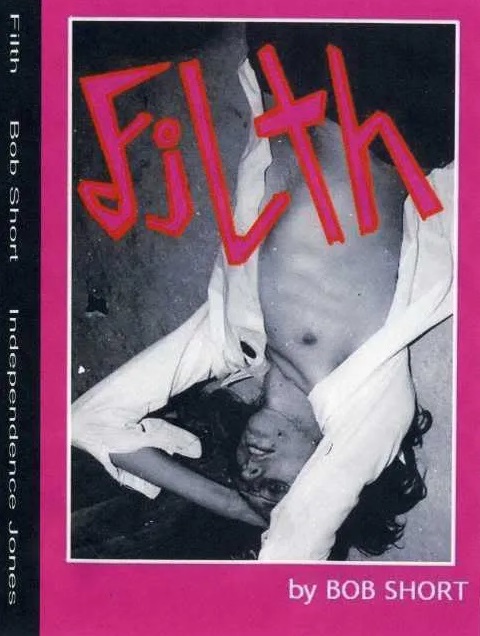
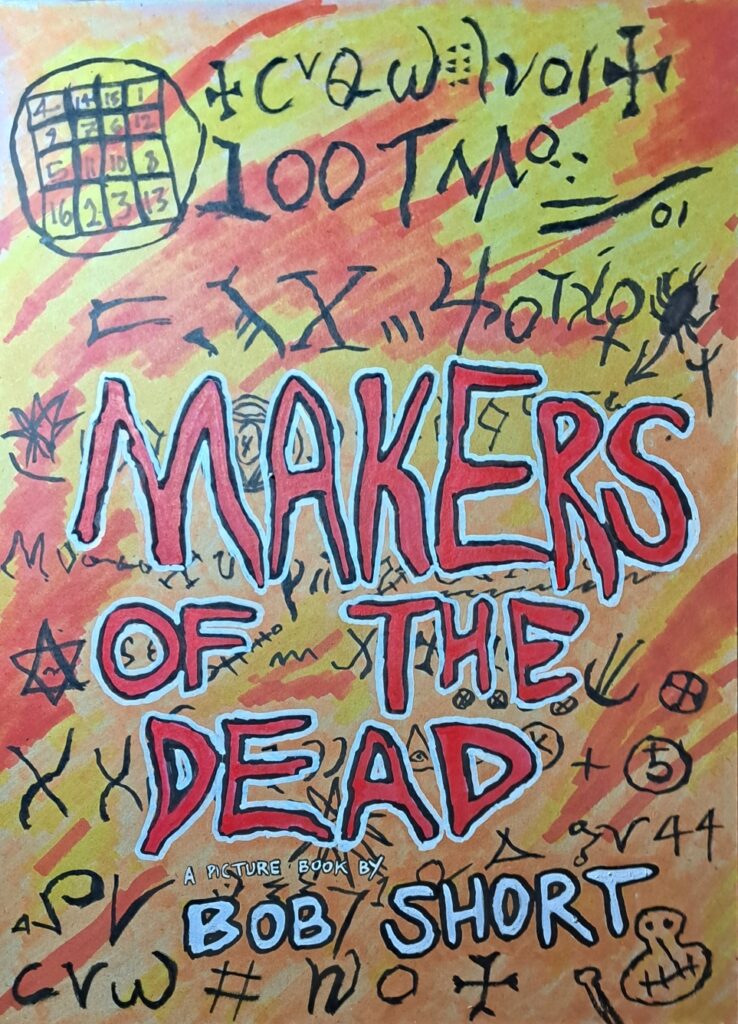
There’s soooo much woven into Red, White and Blue – Did you map it out first or did it just sort of happen as it happened?
Bob Short: It’s actually quite easy to weave plot lines, particularly when writing prose. You just cycle through, speeding or slowing your cuts to match narratives. It became more difficult with a comic because there is a definite limit to length. And some of the prose wouldn’t work with pictures.
The prose version matches the train journey in dreams with a car journey on earth but that wasn’t going to work in the comic.
I knew my story strands and I knew why they were there. I also knew story lines would extinguish each other as it progressed, mirroring discovery through reveals (like psychology as done in the movies).
A big influence on this book was Frank Miller and Bill Sienkiewicz’ Elektra: Assassin in which Elektra loses her mind after being forced to drink “the milk of the beast”. The plot begins in chaos that has to reassemble over eight issues.
The fact that the heroine’s name is Elektra does not go un-noticed.
Structurally, the story is like starting with a frayed rope and working your way back to the rope.
It works when you know what the rope will look like.
Now then, your artistic secrets, please…
Your working method per page, what utensils you’re using, and how on earth do you get those washy-watercoloury effects?
Bob Short: A lot of it is fairly obvious. The early pages in particular were very influenced by the collage style of anarcho punk fanzines (shout out to Kill Your Pet Puppy) and posters like Gee Vaucher‘s Crass cover.
I borrow a lot from Pop culture movie posters of the early twentieth century, original comic books, to an overall creation of a zeitgeisty feel (if that makes any sense). A kind of post modernism hyped on counter culture drugs.
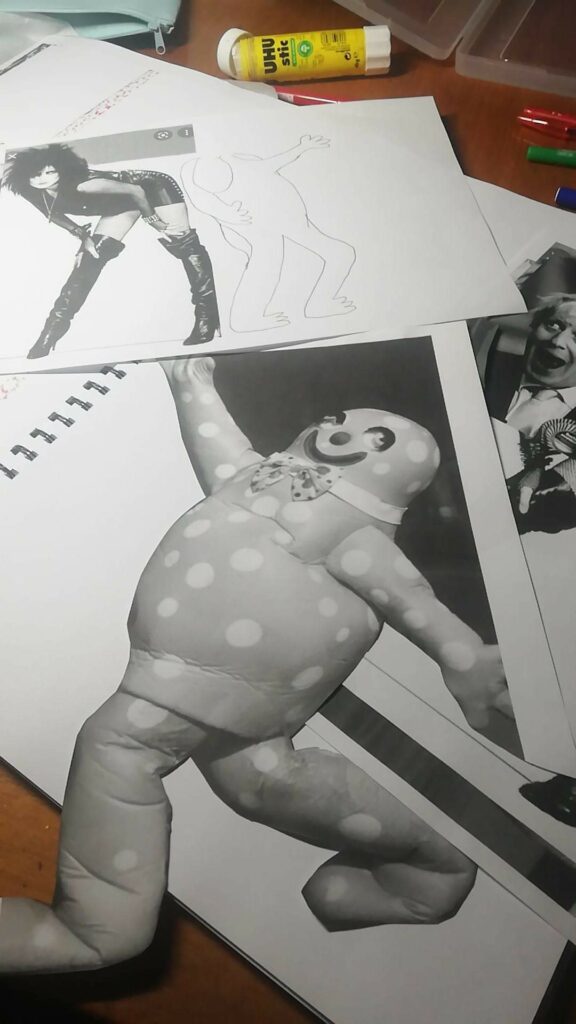
In a lot of ways, it’s an attempt to recreate the anything goes dynamic of Sixties and Seventies underground comics but with a stronger narrative.
When punk began, comics were everywhere. There was of course the comics in Punk Magazine but there were things like photo comics of the Stranglers torturing music journalists.
And no-one was really enforcing copyright.
If Mad could get away with its movie parodies, there was no reason you couldn’t have F(B)atman turn up in your comic.
As for the later pages, my greatest secret weapon was white-out pens. You can make a blue sky out of felt tip or paint pens and add great clouds with white-out. I could also take photocopies and white-out faces.
The original pages are heavy with white-out.
My other secret weapon was always colouring-in outside the line.
It was always important to keep a punk rock do-it-yourself aesthetic. Modern comics really come out of a draftsman’s eyes. I was always fond of the more chaotic.

I love the way you’re blending history – much of it forgotten or avoided – along with a commentary. If it reminds me of anything, it’s Howard the Duck with a dash of Silver Surfer, via a jolly jaunt to Hell (referencing Dante).
Bob Short: This is very much part of the idea of following frayed ends into a rope. The reign of Trump very much blurred truth and fiction, and gave equal weight to both.
It seemed important to balance history with conspiracy theories and blur the line occasionally. It would, for example, help me stop from being sued.
The use of drugs by Hitler and the Third Reich is well-documented. Hitler’s involvement with the occult is equally well-documented but less reliably so. It is the trope that launched a thousand Indiana Jones movies.
The thought of a stoned Hitler trying to seize the body of Dracula just goes with the territory.
I added a generation to one family dynasty to allow the inclusion of a bondage-wearing Tory. And Donald Trump is the only US President in the WWE hall of fame so obviously Ronald Blake bears no resemblance.
Obviously, I am historically indebted to Underground comix like Slow Death and their mutation into the mainstream via Howard the Duck.
The Silver Surfer tilted a little too much towards dope smoking ruminations for my liking but everyone loves a bit of Jack Kirby.
I should also have mentioned the use of comics in the third world (particularly Central America) where familiar icons are subverted against fascism. Because that certainly was on my mind.
Manufactured realities such as Wrestling Kayfabe and the National Enquirer are central to the book’s themes. The story of (my character) Sam Handsome is fairly close to a whispered anecdote about pro-wrestler Stan Hansen.
Is it true?
Was a recent president’s father in the KKK?
Did his grandfather run a brothel in a gold rush town?
The trip to hell was more ‘Orpheus in the underworld’ than Dante but I wasn’t averse to circling the latter.
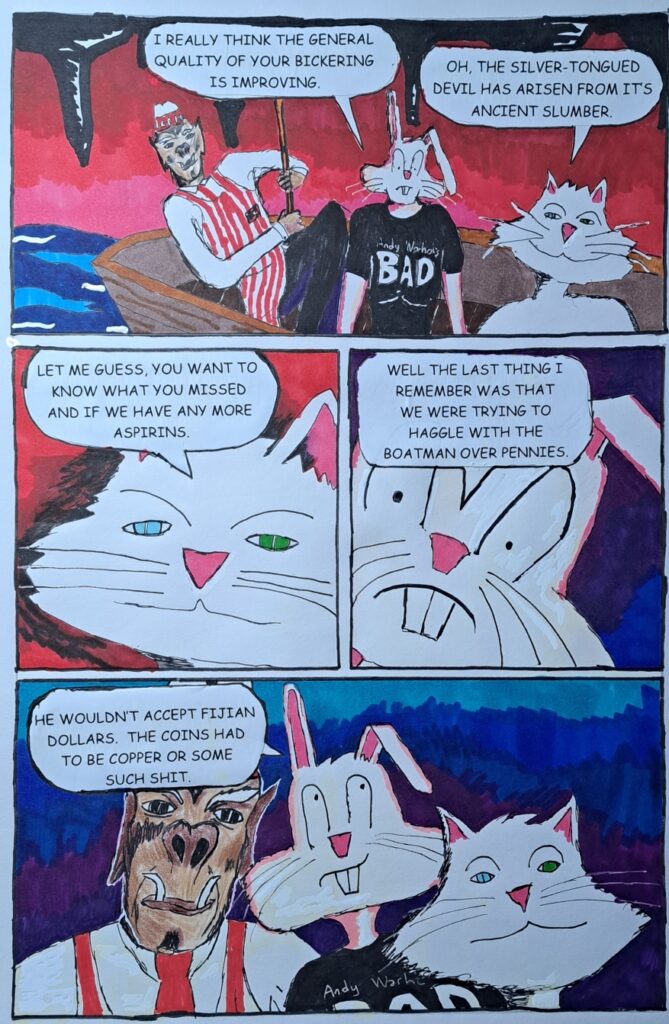
Why the inclusion of Tarot in the comic?
What’s the broader significance?
Bob Short: The Tarot Cards were particularly important in the early issues. Practically, they connect the dream world not just to a psychological journey but also to archetypes of that journey and a sense of mysticism within dreams.
A knowledge of the meaning of the cards used details the character’s position along that journey, but it’s not essential.
The idea that our life can be told in images is important in the sense of expressing stories before the invention of the written word. I like to think a lot of information was passed between humans by paintings on walls and wood-cut prints.
Maybe in Tijuana bibles too.
So, let me throw something your way as a diversion. Just some ideas. Floaty horrid things. Not so much castles in the sky as gallons of water aimlessly defying gravity…
I’ve been in touch with my printer and, after shuffling slowly towards Bethlehem, the last issue, Blue, has arrived. That means I’ve been thinking about this trilogy a lot and why I did certain things the way I did them. And I thought I hadn’t really answered your questions.
Mainly because I didn’t realise certain things at the time.
Usually, I run from any finished project, happy to get things out of my head and behind me.
My first thought is why did I decide to do a comic.
I never thought I could draw a comic.
I did draw comics when I was a kid. They were crude and awful, but The Adventures of Superbug and his endless war with the hordes of Baron Ant and his fiendish Gory Gut Getters machine must have covered several 100 foolscap pages. But I accepted my very limited physical drawing skills would never lead to a career. But there were gig posters and covers and shit along the way – anything were style outweighed substance. (Or is that vice versa?).
But I realised as I begun drawing the comic that there was great humanity in imperfection.
When I started the book, I was already hearing about people submitting work created by AI. I thought, at the time, AI work would be obvious and soulless. Developments in the last two years mean that AI artwork is often unrecognisable as such other than it is perfectly rendered.
So, I’ve become of a mind that technical excellence has no place in modern art.
Whilst waiting to be scanned, some of the pages leached ink on to other pages. My first reaction was horror but then I decided that’s great.
It looks like I spilled my drink.
As I finished the last page of book 3 [Blue], I also realised how much it was about neuro divergence. I hadn’t realised it before I got to the end.
And there was the realisation that punk is largely about neural divergence and a kind of rejection of the psychopathy of liars and lying.
Apropos of the last volume, who on earth is Phillip Arthur Collins?
Bob Short: Let’s field an easy one first. The protagonist was always going to be a Collins, some distant relative of the Collins of Maine and the TV series Dark Shadows. (Also, the Gold Key comic of the early Seventies was the first comic I avidly collected as a child).
When it came to naming her grandfather, I had to find a character from popular culture and hide it with an incorrect middle name because comics need the odd joke to lighten the tone. And the man who invented divorce by fax deserves his place in popular culture. However, Phillip Arthur Collins, as a character, became increasingly more sympathetic with every draft.
I had considered Red, White, and Blue floated an inch or two towards Catcher in the Rye. But Holden seemingly admits to mental breakdown at the end of the book, and that his ill will towards phoniness was in some way delusional – I like to think it is more of a calling. And there is some kind of redemption in accepting oneself as being what once we called a fucking weirdo.
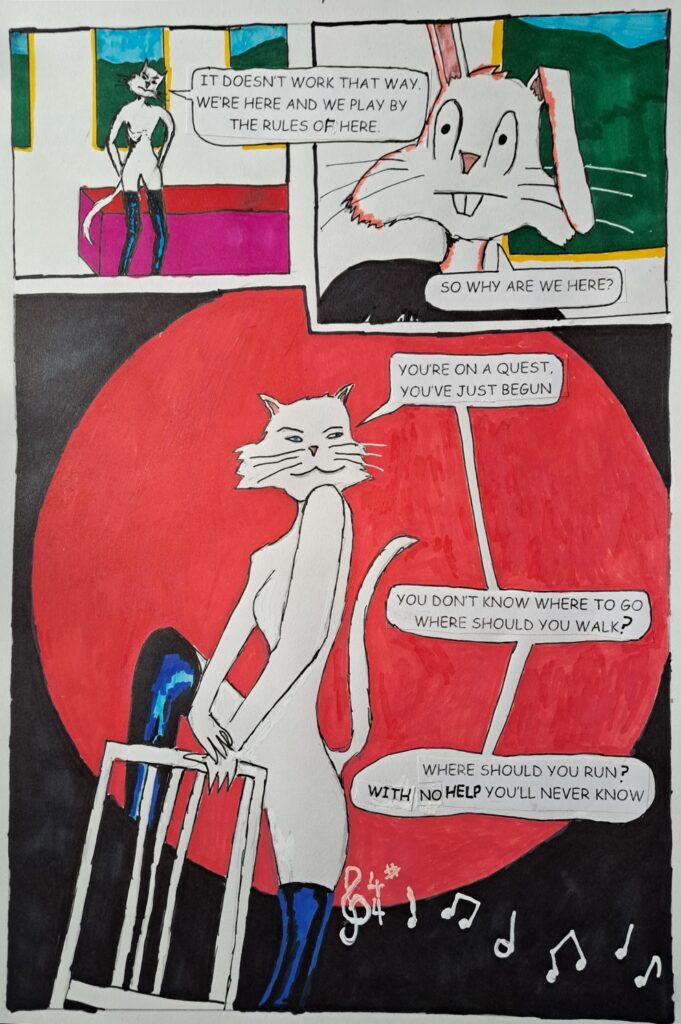
Fucking Weirdo = Full Circle aka Bob’s Thoughts on Punk & Neurodivergence
And here we come full circle, dear reader, because a fucking weirdo is also an outsider. While punks were initially outsiders, there were outsiders before punk, and certainly they existed afterwards.
The reality of the outsider is that there’s usually several reasons that they are an outsider in the first place. And that can often involve poverty – and for most punks that meant near-starvation, malnourishment – and the determination to survive without kowtowing to the expectations of an ordinary life by discovering just what you could achieve creatively with fuck-all money and a shed-load of determination.
Also, while the rejection of mainstream expectations was not mandatory, it was the wallpaper which held the walls together (the paste was their common experience and attitude).
Bob Short: I was just thinking about this shit and I thought I should present my most outlandish theory to you. It is certainly suggested by Red, White, and Blue but I haven’t dared say it out loud. Largely because it is a developing theory.
Here goes…
Punk Rock is an artform that directly exists because of autism.
It directly expresses an autistic world view.
It is an evolutionary attempt by people with autism to seize cultural dominance.
Punk is autistic Darwinism.
It is repulsed and compelled to expose a society that triumphs through deceit.
My first thought on how I’d prepare an explanation of the theory was to type Is Holden Cau– , and the first suggestion that appeared on Google’s list was … ‘field autistic’. I was immediately led to a wealth of documentation that suggested my outlandish theory might be less outlandish than I gave it credit.
Maybe I’ll wait until I get old and go to university and get a degree and make my thesis. In the meantime, I could just throw around evidence and diagnoses via lyrical content:
That first Modern Lovers album. Television. Pere Ubu. Got some soft targets there.
The way Deniz Tek cannot go a verse without mentioning eyes. Usually burning.
Hopefully you have enjoyed this distraction.
Now you know part of why every time I talk or correspond with Bob, I wish I could do it more often.
He recently confided that he is,
“Slightly high on the unexpected arrival of a royalty cheque. 50 pounds.
I am so dignified about the arrival of such pan-scrapings. But it’s still more than I got back in the day.
It might not be living the dream … more a quick peek at the dream through a passing window.”

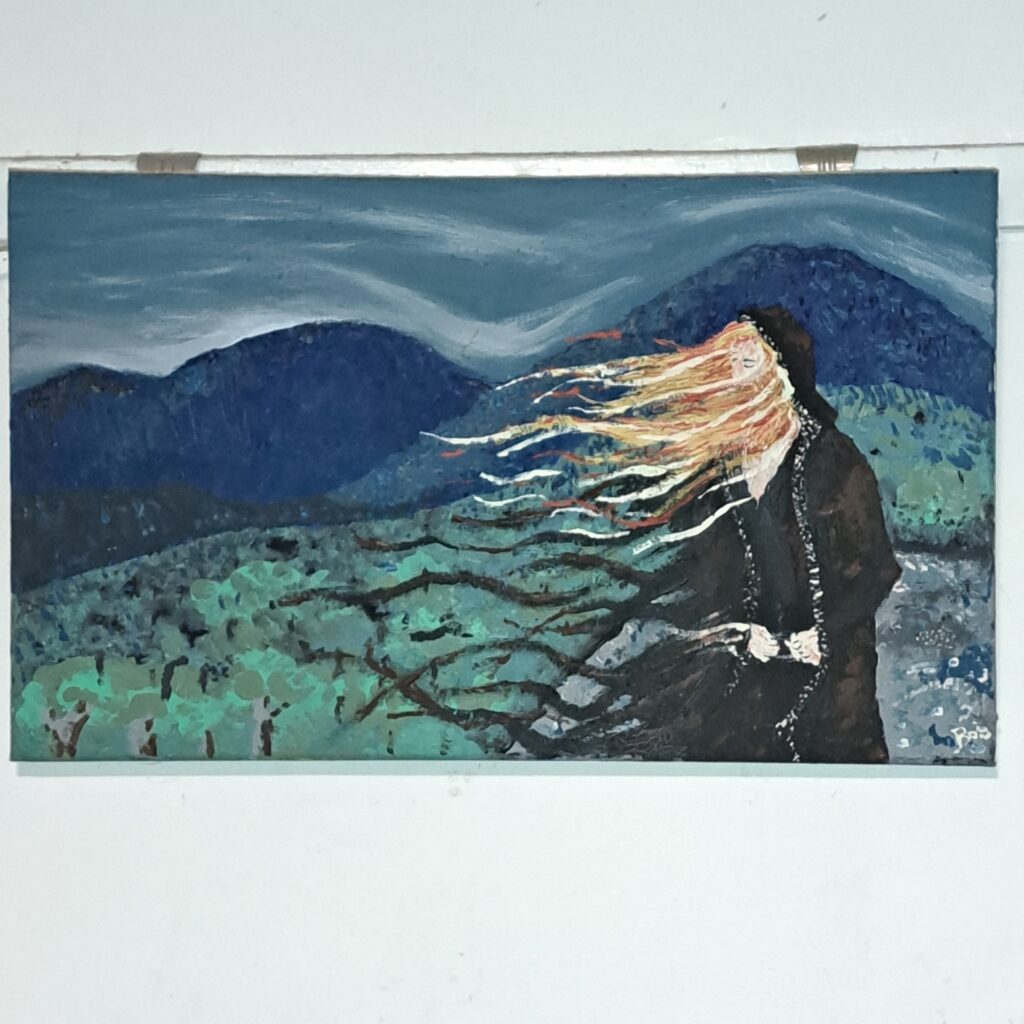
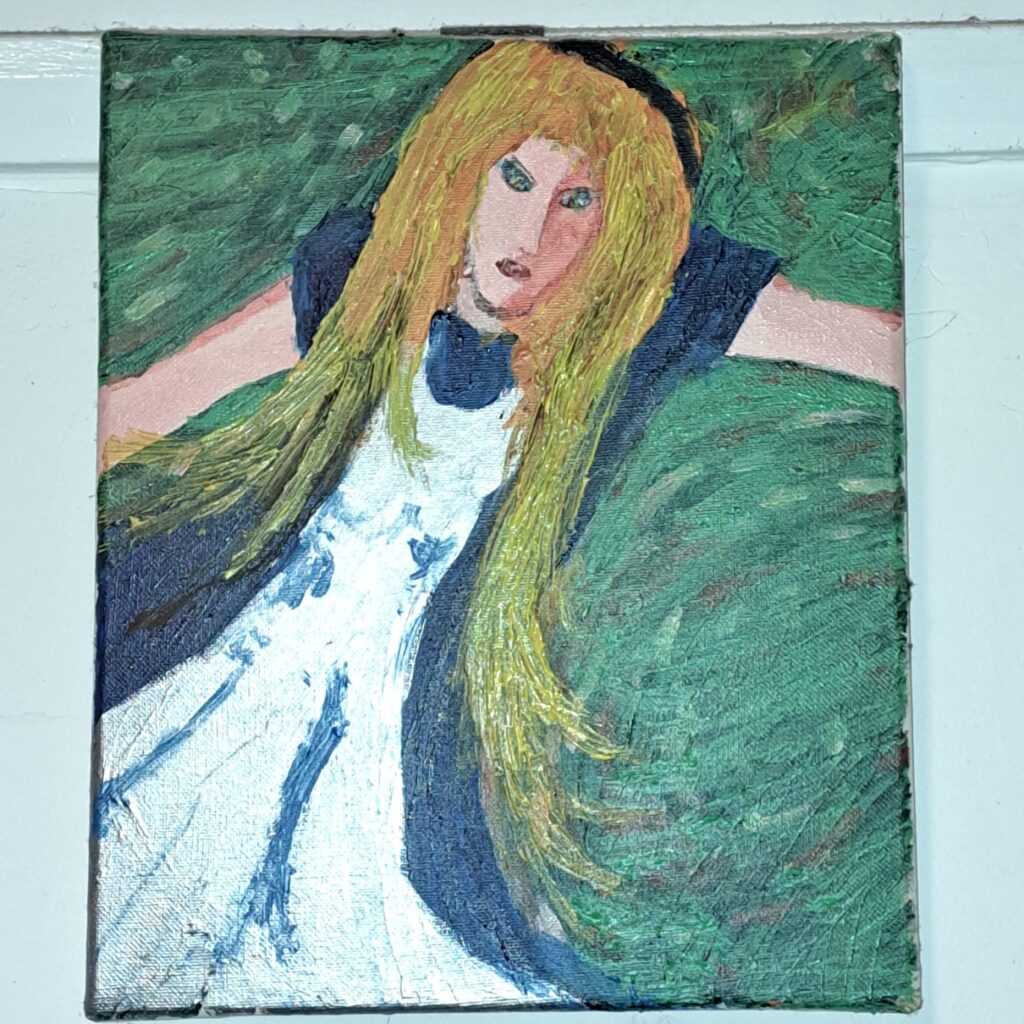

Where Bob Is At Now
Aside from Red, White, and Blue, some other recent Short extraordinary departures from the norm include soundtracks to the 1930s German Expressionist film Nosferatu and the original film White Zombie, a Velvet Underground covers LP which is as eclectic as you could possible imagine, and occasional writing for i94bar.com – just go to the site and punch in his name, it crops up quite a lot.
Also, Bob does a regular segment on Sonny Michael’s streamed Internet broadcast, The Sonny Michael’s Show.
Are you, dear reader, have you finished WTF-ing yet?
But wait, there’s more…
Bob Short: The first Light Brigade LP Going Underground was just an idea to record some songs with other people. The Light Brigade continue as an occasional live indulgence which is always interesting.

With The Light Brigade featuring Bob and a slew of guest musicians.
Currently, I am working on an album of covers of film soundtrack music entitled The Scala after the cinema in London that members of Blood and Roses spent more time in than any established abode.
This afternoon, I’m working on covering the part of ‘Tubular Bells’ they use in ‘The Exorcist’. It’s annoying as fuck because it moves from 4/4 to 3/4 so much, I find myself working in a bizarre 15/4 time signature.
It hurts my head but I’m stupid enough to still want to hurt my head.
I’m hoping to get it released somewhere in Europe.
It’s been shot down in flames by some prospective record companies who are baffled by the idea of an album of movie instrumentals.
And yet, it’s the album I listen to all the time.
It is a passion project that’s coming together nicely but I don’t know if it will find a home.
Maybe if I release it as a Blood and Roses album…
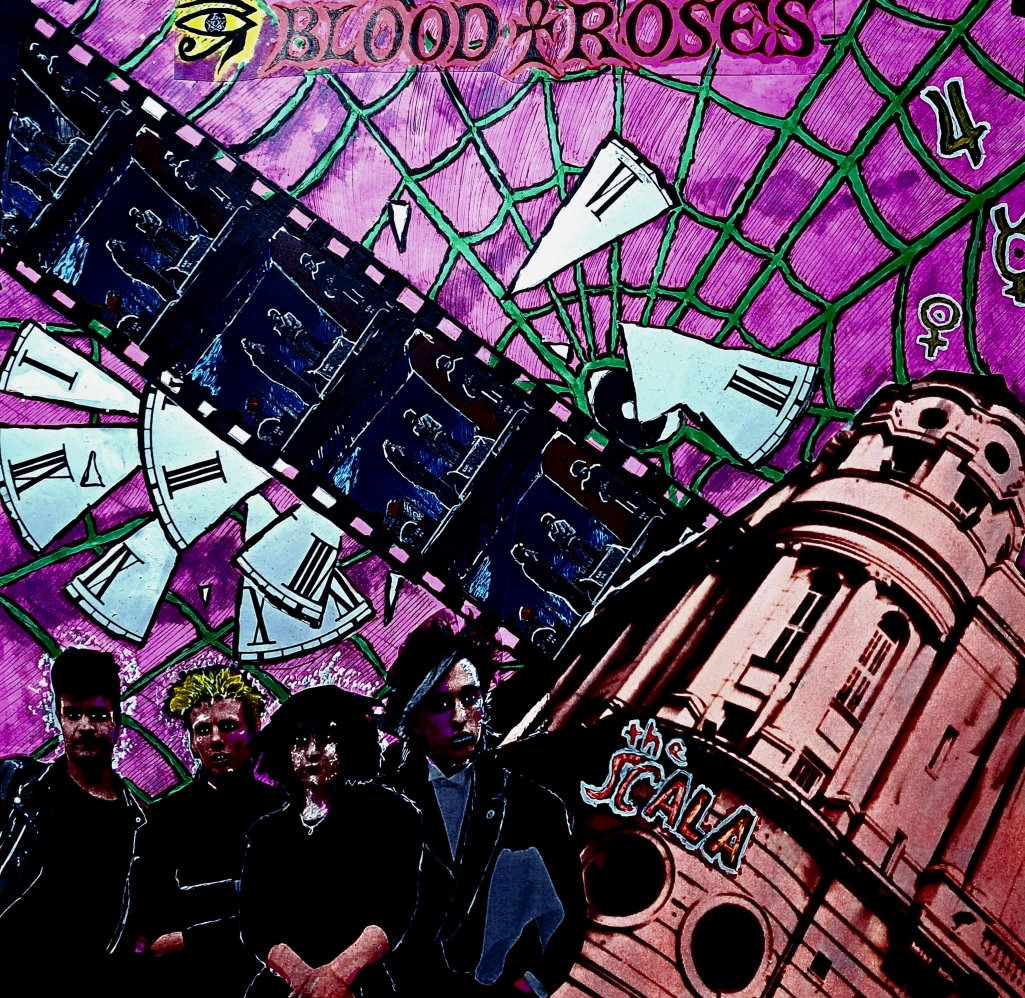
Released under the Blood and Roses name.
As a bit of time has passed since we originally began talking and it getting published…
Is there anything you currently want to plug or are working on – as of May 2024?
I’m currently working on Saga of the Superbug.
Superbug was a comic I wrote when I was about 11. So this is basically the comic I wrote mashed into the world as it was in the early 1970s. Effectively, it is a story about how art (even at its most base) is a reflection of its time.
I generally dream a new project (literally) and try to force it into reality. Many projects get lost to waking up. The awake mind cannot keep up with the dreaming.
I also very much believe in Andy Warhol’s idea about art being work. It is the product you create that defeats death.
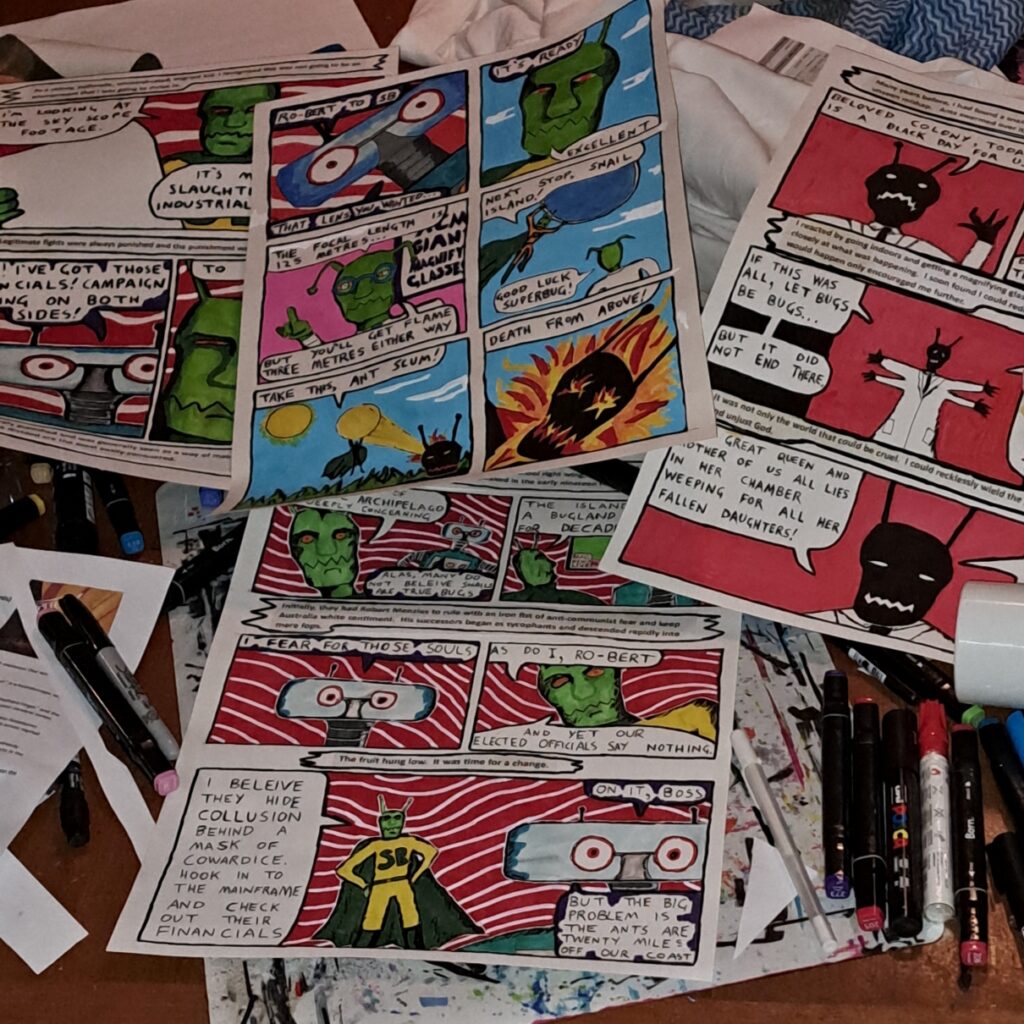
To end – I was wondering, what’s your greatest artistic joy?
Bob Short: A particularly awkward question.
Now I could be shallow and discuss the times either during or after performances when beautiful and/or attractive women jumped on my back and placed their tongues inside my ear.
This happened more often than you’d believe, but less often than I would have liked.
When you ask about greatest joy, this may sound frivolous but, forty years later, these memories remain clear and tantalising.
They also fill me with the pride that I must have been doing something right.
But there are other joys equally profound.
You might think I’d say doing a John Peel session [also known as BBC recording sessions which were then aired by John Peel on his enormously popular radio show] or having my mug plastered over the cover of the NME… and it’s true I’m pretty pleased I got to have that.
But real joys happen when you manage to pluck an idea out of your head and it turns out like you imagined.
Real joy is when everything comes together on stage in all the perfection you hoped.
Real joy is when you do something that exceeds all expectations that make you feel like you’ve plugged into the divine despite your avowed atheism.
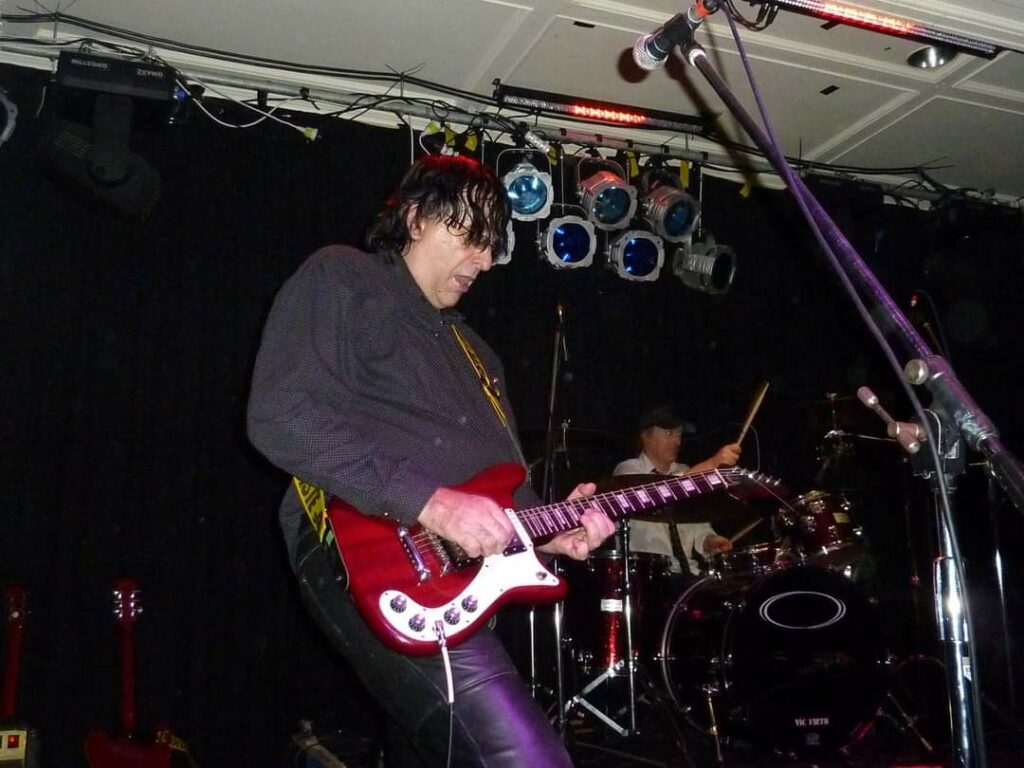
Links
- Bob Short: Email – kxv666@hotmail.com [contact Bob via email to order his comics, art, books etc.]
- Bob Short – Bandcamp
- Bob Short – YouTube
- Bob Short – Facebook
- Bob Short – Discogs Entry
- Bob Short Discusses His London Squatting Days, in a 2007 Article – Link to Read Online via Kill Your Pet Puppy
- Bob Short Discusses His 1983 Peel Session with Blood and Roses, in a 2009 Article – Link to Read Online via KYPP
- The Four Stooges – Facebook
- Blood and Roses – Discogs Entry
- NME Mag, 19th Feb. 1983 Article on Bob, Blood and Roses, and ‘Positive Punk’; by Richard North aka Richard Cabut – Link to Read Online via PunkRocker
- The Face Mag, Feb. 1983 Article on Bob, Blood and Roses, and ‘Positive Punk’; by Marek Kohn – Link to Read Online via PunkRocker
- Article on Blood and Roses from 2012, via Anarcho Scene – Link to read online
- South Of Watford TV Show: 1983 Video Article on ‘Positive Punk’, Featuring Bob – Link to Watch Online via YouTube
- More Info on Early Sydney Punk Scene: ‘Early Sydney punk: Methods in visual ethnography’, by Desmond Thomas Devlin – Link to Read Online via University of Western Sydney
All images supplied by Bob or sourced online.
